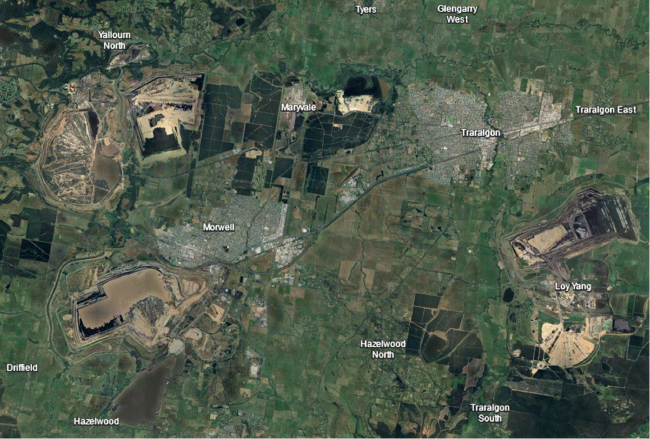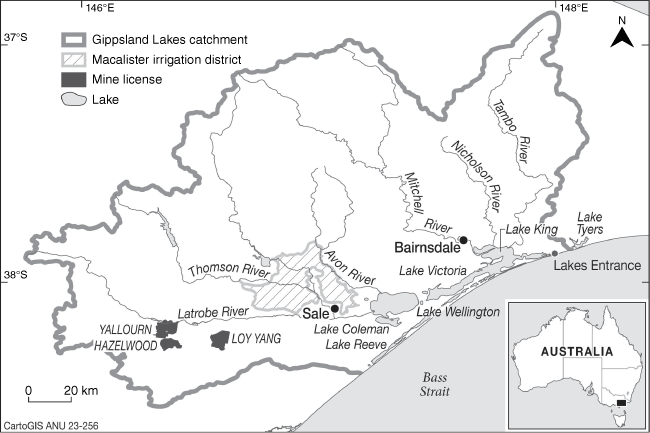Water-cycle and climate-change impacts on the Gippsland Lakes
Jamie Pittock A *
A *
A
Abstract
The environmental health of the Gippsland Lakes substantially depends on freshwater inflows. The quantity and quality of this water is being reduced by the impacts of agriculture, mining, and water transfers to Melbourne. These impacts will be exacerbated by both the direct impacts of climate change and thirsty measures adopted by society to respond to climate change. Changes in water use and increased investment in natural resources management are needed to effectively adapt.
Keywords: agriculture, climate change adaptation, fresh water, Gippsland Lakes, interbasin water transfer, maladaptation, mining, water quality.
Introduction
The state of the ecosystems in the Gippsland Lakes is in large measure contingent on freshwater inflows (especially from the LaTrobe, Avon, Thompson, Mitchell, Nicholson and Tambo rivers) (Fig. 1) that establish the salinity gradient across the lakes system from rivers to the sea (EGCMA 2016). The location of the catchment of the Gippsland Lakes in the difficult mid-latitudes means that large climate change impacts that diminish water quantity and quality are likely. Further, there is a need to assess not only the direct climate-change impacts on water but also the consequences of how society chooses to manage water differently in response. In this synthesis, some information is drawn from the better-researched Murray–Darling Basin immediately north of the Gippsland Lakes catchment.
Water volumes and flow timing will change
Rainfall in southern Victoria is projected to decline with climate change. Inflows into reservoirs in central Victoria have already fallen by 21% since 1975 (DELWP 2022). Percentage changes to river-basin aggregated annual runoff for East Gippsland for 2065 under emissions pathway RCP8.5 (relative to 1975–2014) range from a +21% for low impact, to -18% in the median and -39% in the high-impact scenarios (Potter et al. 2016). These declines are anticipated to be greater in winter and spring. Further, greater extremes of floods and droughts are expected. In all, there is a high probability of declines of freshwater inflows into the lakes. In extreme droughts, saline waters could be expected to flow a long way inland with consequent negative impacts on populations of freshwater flora and fauna.
Water quality will decline
Unfortunately, there are many ways in which water quality will decline in a changing climate (Pittock 2009; Baldwin 2021; DELWP 2022). Higher average temperatures will impact on freshwater ecosystems (Potter et al. 2016). Greater climatic extremes and more frequent severe fires would see more sediments, nutrients and other pollutants washed into the rivers and ultimately the lakes. Cyanobacteria blooms are likely to increase in frequency. Potential acid sulfate soils may desiccate and oxidise in severe droughts (Agriculture Victoria 2019).
Changes in water management in the catchment may further diminish inflows
A number of changes in the way that water is managed in the catchment of the Gippsland Lakes may exacerbate or lessen the impacts on water availability. The population of the region and urban water demand are increasing (DELWP 2022). The closure of coal mines and power stations in the Latrobe Valley (Fig. 2) brings the opportunity to reallocate the large volumes of water allocated for cooling power stations to environmental flows and Traditional Owners (DELWP 2022). However, the proposals to flood the former mining voids may take vast volumes of water over 30 years (Whittaker 2020). Despite increasing water scarcity, the Victorian Government also proposes new irrigation areas in the lower Latrobe region and in the Macalister and Avon systems (DELWP 2022).
Google Earth image showing the coal mining areas in the Latrobe Valley. Map data © 2024 Google.

As direct climate-change impacts worsen it is likely that societal responses will further diminish river inflows, for example, with measures to maximise rainwater harvesting on farmlands, or increased transpiration from tree planting for carbon sequestration (Pittock et al. 2023). Thorough regulation of groundwater will be required to prevent switching to and over extraction of groundwater, for instance, there are areas of declining groundwater levels on the Red Gum Plains (west of Bairnsdale) (EGCMA 2022).
Some societal response options
There is an urgent need to step up considerations of options for managing water in a changing climate to conserve the Ramsar wetlands of the Gippsland Lakes. Among those options are:
reducing water allocations and the balance of water allocation between consumptive and environmental uses as water availability diminishes (Lindsay 2021)
more water-use efficiency, recycling and desalination (DELWP 2022)
setting pre-eminent downstream environmental flow targets linked to thresholds needed to conserve key environmental and cultural assets (Baldwin 2021), and protecting the few remaining free-flowing rivers (Pittock and Finlayson 2011
monitoring and regulating risks to shared water resources, such as water storage on farms and tree planting (Pittock et al. 2023)
building on Catchment Management Authority programs to systematically restore riparian zones, including removing barriers to fish passage, fencing out livestock and restoring native vegetation (EGCMA 2016; WGCMA 2016).
Finally, the limited current ownership (2 GL/year entitlement) and management opportunities for Traditional Owners of their fresh waters is unjust (GLAWAC 2023). Funding Traditional Owners would be one way of implementing a number of these response options, for example, through more investment in Indigenous land and water management programs.
References
Agriculture Victoria (2019) Coastal Acid Sulfate Soils Distribution. Map 5 for Gippsland Lakes, Victoria. Available at https://vro.agriculture.vic.gov.au/dpi/vro/vrosite.nsf/pages/vic_acid_sulphate_map5
Pittock J, Finlayson CM (2011) Australia’s Murray-Darling Basin: freshwater ecosystem conservation options in an era of climate change. Marine and Freshwater Research 62, 232-243.
| Crossref | Google Scholar |
Pittock J, Corbett S, Colloff MJ, Wyrwoll P, Alexandra J, Beavis S, Chipperfield K, Croke B, Lane P, Ross A, Williams J (2023) A review of the risks to shared water resources in the Murray–Darling Basin. Australasian Journal of Water Resources 27, 1-17.
| Crossref | Google Scholar |
Whittaker J (2020) Latrobe River earmarked as water source in plan to turn coal mines into lakes. ABC Gippsland, 8 February. Available at https://www.abc.net.au/news/2020-02-08/plan-to-turn-victorias-coal-mines-into-lakes/11942972


